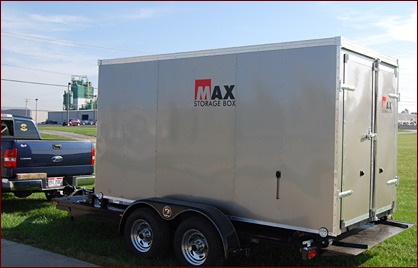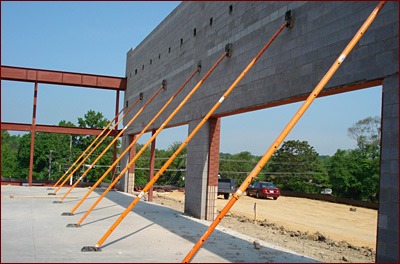December 2008
Scaffolding
 An Inside Look at Scaffold Accessories
An Inside Look at Scaffold Accessories
Products that help masons stay OSHA compliant and work safer, faster
Accessories make scaffolding systems more accessible, easier to use, and safer for workers. They’re also instrumental in making scaffolding compliant with Occupational Safety and Health Administration (OSHA) regulations, which is attracting masonry contractors’ attention.
“The demand [for accessories] is growing, primarily because OSHA is starting to step up its inspections and we’re seeing it in waves,” says Mike McAnnally, national sales manager for Memphis-based Stepup Scaffold. “OSHA will go in and blanket a city, sending contractors scrambling to make their scaffold OSHA compliant.”
Accessories that make scaffolding safer and OSHA compliant are relatively inexpensive in the overall picture of what masonry contractors invest in scaffolding for their jobs, according to McAnnally.
“If your biggest interest is protecting employees, having low insurance premiums, and not getting a fine from OSHA, you should get the accessories you need,” he says.
Removing Guard Rails, Keeping Dry
Masonry workers usually have to physically remove a guard rail when it’s time for a forklift or telehandler to set materials on the scaffold. Granite Industries Inc. in Archbold, Ohio, has a better way: a sliding guardrail that doesn’t need to be removed.
“You slide the brace back, put your load of brick or block on the scaffold, then slide it back closed, and away you go,” says Matthew Wyse, VP of sales and marketing for the company. “It allows a company, instead of removing a brace, to slide the brace open. It’s a lot safer, and it saves time.”
Workers need to open only the bay where the load will be placed, he says. The guard rail slides closed, which meets the OSHA requirement for replacing the rail once the load has been set in place.
“Safety directors and OSHA will think this is great,” says Brendt Johnston, engineer for Granite Industries who designed the sliding guard rail. “When the guys are up there doing masonry work, they’re always behind the guard rail. When you have to set something on the scaffolding, you just go up and slide the rail so you’re always behind it.”
The time saved by not removing guardrails will quickly add up during the course of a project, he says. “The forklift guy doesn’t have to wait for five minutes every time for the guy to take the brace off.”
Another scaffolding company offers a product for keeping masonry workers dry in inclement weather. Columbus, Ohio-based TNT Equipment Inc. has a bracket that fits over frame scaffold to hold a cover in place for protection against the elements.
“The bracket is used for providing a water cover,” says Michael Solomon, U.S. sales manager for the company. “It’s a bracket everyone can use. It locks onto the scaffold, so you can use your existing scaffold and it will keep out the rain, wind and all the elements.”

![]()
Image courtesy of Granite Industries
Accessories for Almost Everything
When renting or buying scaffolding, masonry contractors need to consider everything that’s needed for the job, including accessories, Stepup’s McAnnally says.
“Contractors aren’t trying to sidestep or save money by not getting accessories; they just don’t think of it,” McAnnally says. “They know they need 100 feet of scaffold for a job, because they figure five guys can cover 20 feet of wall. But they don’t think of guard panels for the ends and other accessories that they need.”
Stepup has end guard panels, side brackets, and P-brackets that fit on top of side brackets to make scaffolding safer and more versatile, he says. “The average end-user, like a masonry contractor, may not know that we have end guard panels they can use.”
Storage is also an issue that masonry contractors often overlook. Granite Industries has a solution for storing scaffold accessories, and almost anything else, on the jobsite. The company’s MAX portable storage box serves as a giant locker for secure onsite storage.
“This is for masons who are looking for ways to keep their materials, items and scaffolding accessories safe on the jobsite,” Wyse says. “It’s an inventory management tool. It takes the POD concept and applies it to jobsite storage.”
Chad Kern, head of inside sales for Granite Industries, says masonry contractors can haul the storage box on an 18-foot trailer. Workers manually push the box off the trailer to unload it, then use a power wench to load it back onto the trailer.
“You can have 10 of these boxes, and you only need one trailer,” Kern says, noting that the box can be lifted and placed on the second floor of a building. “It’s basically a storage area that’s very mobile.”
Use the Right Accessory for the Job
McAnnally says Stepup and other manufacturers offer more than 100 accessories. Stepup’s accessories are designed to fit on the scaffolding, so they do a better job of protecting workers than makeshift substitutes that workers improvise on the jobsite, he says, adding that manufactured accessories can also save time and money.
“The main thing with using the right accessory is contractors don’t have to worry about their employees getting hurt,” McAnnally says. “It’s more labor efficient if you use the right part. It’s designed to go in quickly and do the job. The products are very inexpensive. They start at about $15 to $20. We’re not talking large money items to make their employees safe.”
Charles Dewey, VP of scaffold and erection services for Cleveland-based Waco Scaffolding and Equipment, agrees. “Most of the accessories that are necessary to ensure workers’ safety with respect to scaffolding have been around for many years,” Dewey explains. “These accessories include guardrail systems, access ladders and stairways, proper decking materials intended for masonry use, as well as systems to properly tie the scaffolding to a structure. The big issue with these accessories is, obviously, that they don’t work if they are not used.”
The reasons they’re not used probably boil down to economics and ignorance, he says. “Economic reasons are simple. The perception is that it costs more money to rent or buy these items and for labor to use them than to do nothing, especially so if no one gets hurt and OSHA or a GC doesn’t get involved to insist on compliance with safety rules and regulations,” Dewey says. “Ignorance [is] simply in the fact that the workers don’t have the proper training to understand the hazards and how to deal with them.”
|
